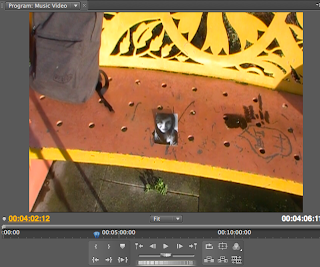The series of images below show examples of the various types of shots that we have used within our music video, and an explanation as to why we have used them.
Above: This image shows a close-up shot. We have used these on a few occasions to show the artist's expression which consequently allows us to see how he is feeling. In this particular example, the fact that his eyes are closed and his head is pointing slightly downwards, show that he is deep in thought - he is thinking about his ex-lover and being nostalgic about their past together.
Above: This image shows a high-angle shot. This kind of shot is very effective because, as shown in this example, the camera points down on the subject to show their dominance within the narrative - although the character isn't inferior to any other people, the use of this shot shows that he is of a vulnerable and saddened state, due to the way he is feeling. The fact that people are looking down on the subject shows that they probably think less of him, and think he is somewhat deluded and pathetic because what he is doing (waiting for a girl/refusing to move), and hopes to achieve out of doing it (rekindling their relationship) doesn't seem very realistic. This adds to the severity of the inferiority within the video, and allows the audience to grasp how he is feeling.
Above: This image shows a medium shot. We have used these quite regularly, as they are a very popular shot in all types of videos. We have used it so that the viewers can focus on the character and what he is saying/the emotions he is expressing, but can also simultaneously see what kind of set and props are being used to add to the feeling that is being evoked. In this example, it is obvious that he is sitting down on a bench, which coincides with the lyrics and how he refuses to move. In terms of props/mise en scene, he is wearing a grey top - grey being a colour typically associated with dullness, which adds to the mood given off in the video.
Above: This image shows a pan-right shot. We have only used this once at the very beginning of the video. We decided that it would be appropriate to use this shot, followed by a tracking shot following the subject, because it allows the viewer to absorb everything necessary - the surroundings, to see where the video is going to be mainly set, and it allows them to feel as though they are actually there with the man, walking with him, which adds to the reality of the video, and therefore allows them to realise how realistic and deep his feelings are.
Above: This image shows an over-the-shoulder shot. We decided that this would be effective to use to go with the lyrics "got your picture in my hand" - using this type of shot would give the viewers a clear view of the picture and allow them to clearly see what it is of - in this case, his ex-lover. Using this prop again allows the viewers to realise how passionate he is about the relationship he once had, and how much he misses her ex-lover. This therefore adds to the depressive mood that is evoked.
Above: This image shows a wide shot, and they have been used on quite a few occasions in the video. As with the medium shot, it allows the viewers to focus on the character(s) and what he is saying/the emotions he is expressing, but also to be able to see everything else that is going on in the video that is key to the main action.
Above: This image shows a low-angle shot. We used this in the scene that involved the police-officer, in order to show the authority that he holds over not only the man in the video, but the public and its people as a whole. This shot is particularly effective as it allows the viewers to recognise the authority of this figure, and the way that he is looking down on the man on the bench depicts how the man is feeling vulnerable and perhaps scared.
Above: This image is of another close-up shot. However, this particular one has been used in a different style to the others. With this one, I held the camera with my hand, and manually walked round the man. Originally, I filmed this shot with no intention of actually using it, and instead thought I would just do it anyway as it is different to the rest of the shots. When editing, Tyrone incorporated it to see what it would look like, as there was an empty section of the video which needed to be filled up, and we decided that it looked quite effective and hence decided to use it.

Above: These two images show the use of a zoom shot. We have used these on a few occasions within the video because they focus on a particular part of the video that we, as the directors, want the audience to focus on, and it therefore allows them to do so. The one above has been used at the end of the video where the man's ex-lover gets to the corner, but he has gone, and all she sees is the picture of her on the bench. The first image is of the picture when she first seems it, and the second is of when it is zoomed in on to allow the viewers of the video to really absorb it and recognise the motif of the video, i.e., that upon being forced to, the man leaves, at which point the woman turns up.
Written by Jack.









No comments:
Post a Comment